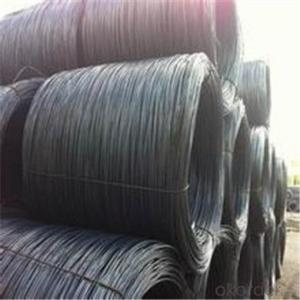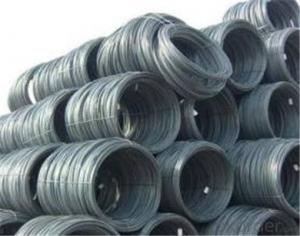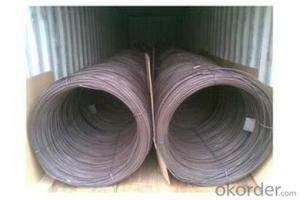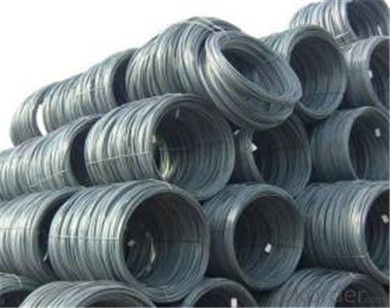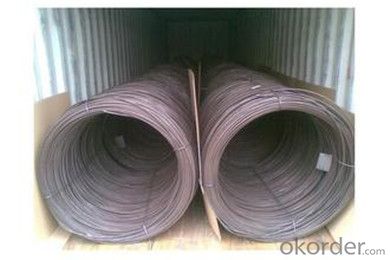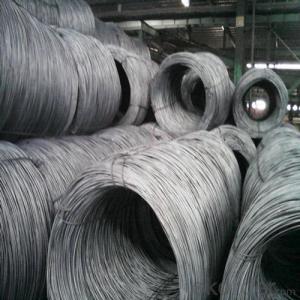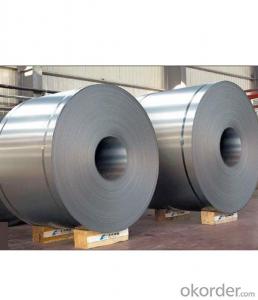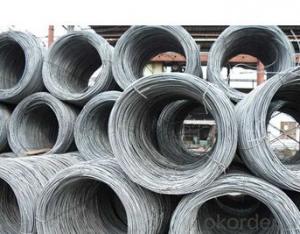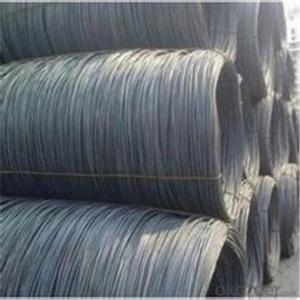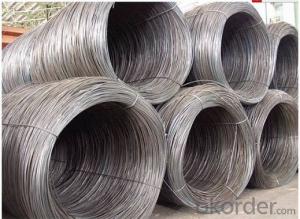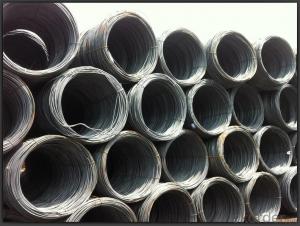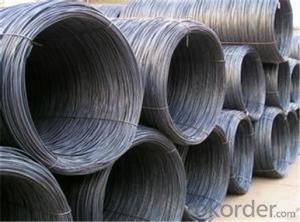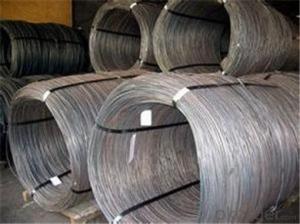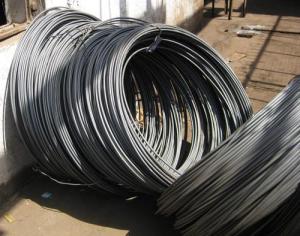SAE1006B Steel Wire Rod 6.5mm with Best Quality in China
- Loading Port:
- Tianjin
- Payment Terms:
- TT OR LC
- Min Order Qty:
- 200 m.t.
- Supply Capability:
- 45555555 m.t./month
OKorder Service Pledge
OKorder Financial Service
You Might Also Like
Specification
Description of wire Rod:
1. Drawn wire specialist, your wire rod solution
2. ISO9001 Certified Mill &SGS
3. Feature: machinability, high hardness, toughness, corrosion resistant
Festures of wire Rod:
1. Drawn wire specialist, your wire rod solution
2. ISO9001 Certified Mill &SGS
3. Feature: machinability, high hardness, toughness, corrosion resistant
4. Clear and smooth surface, high precision and Tolerance control: ± 0.01
Specifications of wire Rod:
Product | steel wire rod |
Standard | AISI, ASTM, BS, DIN, GB, JIS |
Material/steel grade | Q195-Q235,SAE1006, SAE1008, SAE1010, SAE1018, SAE1020 or according to customers requirements |
Wire Gauge | 5.5-12mm |
Coil weight | 1.8-2.1mts |
MOQ | 25MT |
Delivery Time | 15-30 days after receipt of L/C or deposit by T/T |
Packing | In coil and load in container, if large quantity, by bulk vessel; Can be packed as customers' special requirements |
Payment terms | 1).100% irrevocable L/C at sight. |
Application | widely used in machinery parts, manufacturing industry, electronics industry, metal tools and others |
Images of wire Rod:
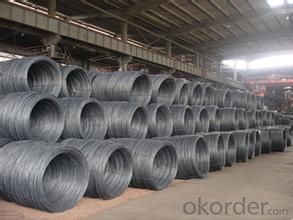
FAQ:
1. What is your package?
Packing situation: standard seaworthy packing or as customer required.
2. How long is the lead time?
Delivery time: 45 days after order confirmed.
3. What payment term do you accept?
Payment: T/T or L/C at sight.
- Q: What are the different sizes of steel wire rod available?
- The sizes of steel wire rod available vary depending on the specific requirements and applications. Common sizes range from 5.5mm to 16mm in diameter, with variations in length and weight. Custom sizes can also be produced to meet specific needs.
- Q: What are the different types of steel wire rod surface defect visualization techniques?
- There are several techniques used for visualizing surface defects in steel wire rods. These include visual inspection, magnetic particle inspection, dye penetrant inspection, eddy current testing, ultrasonic testing, and X-ray inspection. Each technique has its own advantages and limitations, and the choice of technique depends on the specific requirements and characteristics of the steel wire rod being inspected.
- Q: What are the recent developments and innovations in steel wire rod production?
- Some recent developments and innovations in steel wire rod production include the introduction of advanced wire rod mills that utilize high-speed rolling technologies, such as the MEERdrive® system, to increase productivity and improve product quality. Additionally, there have been advancements in the use of automation and artificial intelligence to optimize the production process, reducing energy consumption and minimizing waste. Furthermore, manufacturers are investing in research and development to develop new alloys and coatings that enhance the strength, durability, and corrosion resistance of steel wire rods, expanding their applications in diverse industries such as automotive, construction, and aerospace.
- Q: How is the steel wire rod market affected by mergers and acquisitions?
- Mergers and acquisitions have a significant impact on the steel wire rod market. When companies in this industry merge or acquire each other, it results in consolidation within the market. This consolidation can have both positive and negative effects on the overall dynamics of the market. One of the main consequences of mergers and acquisitions in the steel wire rod market is a potential decrease in competition. When two or more companies merge, they combine their resources, production capabilities, and market share. This creates a larger and more dominant player in the industry, which can lead to reduced competition. As a result, the merged entity gains more control over pricing and market conditions. On the positive side, mergers and acquisitions can also generate economies of scale. By merging operations and streamlining processes, companies can achieve cost savings and improve efficiency. This, in turn, can lower production costs, potentially leading to lower prices for customers. Additionally, the merged entity may gain access to a wider customer base and distribution network, allowing them to reach new markets and increase their market share. However, there are also potential downsides to mergers and acquisitions in the steel wire rod market. Consolidation may result in job losses as duplicate positions are eliminated to achieve cost synergies. Moreover, if the merged entity becomes too dominant in the market, it may have the power to dictate terms to other market participants, potentially limiting choices and options for customers. Overall, the impact of mergers and acquisitions on the steel wire rod market depends on various factors, such as the size and scope of the merger, the market structure, and the competitive landscape. While consolidation can bring about positive and negative effects, it is crucial for regulators to monitor and ensure fair competition to protect consumer interests and maintain a healthy market environment.
- Q: How is steel wire rod used in the production of electrical conductors?
- Steel wire rod is a crucial component in the production of electrical conductors. It is used as a raw material to manufacture various types of wire and cables that are essential for the transmission and distribution of electricity. The process begins with the steel wire rod being drawn through a series of dies to reduce its diameter and increase its length. This drawing process not only strengthens the wire but also enhances its electrical conductivity. The resulting wire is then further processed to meet specific requirements for electrical conductors. Steel wire rod is widely used in the production of power cables, which are used to transmit electricity over long distances. These cables consist of multiple layers, including a conductor made from steel wire rod. The conductor provides a path for the electrical current to flow, enabling the transmission of power from power plants to various locations. In addition to power cables, steel wire rod is also used in the production of electrical wires and cords. These wires are used in residential, commercial, and industrial applications to connect electrical devices and appliances to power sources. Steel wire rod is chosen for its high tensile strength and durability, ensuring that the wires can withstand the demands of daily use. Furthermore, steel wire rod is used in the manufacturing of overhead transmission lines. These lines are essential for the distribution of electricity from substations to local power grids. Steel wire rod is used to create the conductive strands within these transmission lines, enabling efficient and reliable power distribution. Overall, steel wire rod plays a vital role in the production of electrical conductors. Its strength, conductivity, and versatility make it an ideal material for manufacturing power cables, electrical wires, and transmission lines. Without steel wire rod, the efficient transmission and distribution of electricity would not be possible.
- Q: How are steel wire rods used in the manufacturing of wire baskets for organizing items?
- Steel wire rods are a crucial component in the manufacturing of wire baskets used for organizing items. These rods are primarily used to form the structure and framework of the basket, providing strength and durability. To create wire baskets, the steel wire rods are first processed through various manufacturing techniques such as drawing, annealing, and galvanizing. Drawing involves pulling the rods through a series of dies to reduce their diameter and achieve the desired thickness for the basket. Annealing, a heat treatment process, helps to relieve stress and improve the flexibility and malleability of the rods. Galvanizing is often done to protect the steel wire rods from corrosion, making them more suitable for long-term use. Once the steel wire rods are prepared, they are then shaped into the desired basket form. This is typically done by bending and welding the rods together to create the basket's frame and mesh structure. The rods are bent using specialized machinery that can form them into the required shape, such as a square, rectangular, or circular basket. During the welding process, the rods are joined together at various points to ensure the stability and strength of the basket. This welding process can be done manually or through automated machinery, depending on the scale of production. Welding not only reinforces the structure but also enhances the durability of the wire basket, making it capable of withstanding heavy loads and constant use. Once the basic structure is formed, additional features such as handles, dividers, or compartments may be added to the wire basket. These features can be attached to the steel wire rods either through welding or other fastening methods, providing further organization and convenience for users. Overall, steel wire rods play a vital role in the manufacturing of wire baskets for organizing items. Their strength, flexibility, and corrosion resistance make them ideal for creating sturdy and durable baskets capable of organizing and storing various items efficiently.
- Q: What are the main factors influencing the choice of steel wire rod end-user?
- There are several main factors that influence the choice of steel wire rod end-user. First and foremost, the quality and composition of the steel wire rod play a crucial role in the decision-making process. End-users look for wire rods that have high tensile strength, good ductility, and excellent corrosion resistance. These properties ensure that the wire rod will perform optimally in their specific application, whether it's for manufacturing automotive parts, construction materials, or electrical wires. Another important factor is the price of the steel wire rod. End-users carefully consider the cost-effectiveness of the wire rod, as it directly impacts their production costs. They compare prices from different suppliers and evaluate the balance between quality and price to find the most suitable option for their needs. Additionally, the availability and reliability of the supplier are significant factors influencing the choice of steel wire rod end-user. End-users prefer suppliers who can consistently provide the required quantity and quality of wire rod within the desired timeframe. A reliable supplier ensures a steady supply chain, minimizing any production delays or disruptions. Furthermore, technical support and customer service offered by the supplier are essential considerations. End-users appreciate suppliers who can offer assistance and guidance in selecting the right wire rod for their specific application. This support can include recommendations on material selection, technical specifications, and after-sales services, which contribute to a long-term and successful partnership. Lastly, environmental sustainability is becoming an increasingly important factor in the choice of steel wire rod end-user. Many end-users prioritize suppliers that demonstrate a commitment to sustainable practices, such as using recycled materials or reducing carbon emissions. This aligns with their own corporate social responsibility goals and helps them meet regulatory requirements. In conclusion, the main factors influencing the choice of steel wire rod end-user include the quality and composition of the wire rod, its price, the availability and reliability of the supplier, the technical support and customer service provided, and the supplier's commitment to environmental sustainability.
- Q: What are the different types of steel wire rod packaging options after wire drawing?
- Steel wire rods have various packaging options available after wire drawing. These options aim to safeguard the wire rods during storage, transportation, and handling. The packaging options for steel wire rods include the following: 1. Coils: Coils are a commonly used packaging option for steel wire rods. They involve winding the wire around a cylindrical core to create a compact and secure package. Coils are easy to handle, stack, and transport, and are available in different sizes to accommodate different wire rod weights. 2. Spools: Spools are another popular packaging choice, particularly for smaller diameter wire rods. The wire is wound around a spool, providing a well-organized and controlled arrangement. Industries that prioritize precision and ease of use, such as electrical and electronics industries, often opt for spools. 3. Straight bars: Occasionally, larger diameter and length wire rods are packaged as straight bars. This option is suitable for wire rods that will undergo further processing or need to be cut into specific lengths for particular applications. 4. Bundles: Bundles are created by tying together multiple wire rods using straps or wires. This packaging option is commonly used for longer wire rods that cannot be coiled or spooled. Bundles offer stability and protection during transportation and storage. 5. Pallets: Pallets are used for bulk quantities of wire rods. The wire rods are stacked and secured on wooden or plastic pallets, ensuring easy handling and efficient storage. Pallets are ideal for larger wire rod shipments and enable convenient movement using forklifts or pallet jacks. 6. Containers: Containers are employed for international shipments or long-distance transportation of steel wire rods. They provide a secure and protected environment, shielding the wire rods from moisture, dust, and other external factors during transit. Choosing the appropriate packaging option is crucial, taking into account the size, weight, and specific requirements of the steel wire rods. Proper packaging guarantees the integrity and quality of the wire rods, reducing the risk of damage and facilitating efficient handling and transportation.
- Q: How is steel wire rod used in the manufacturing of wire racks?
- Steel wire rod is used in the manufacturing of wire racks as it serves as the primary material for creating the framework and structural support of the rack. The wire rod is typically bent and shaped into the desired dimensions and configurations to form the frame of the rack. Additionally, it provides strength and durability to the rack, ensuring it can hold and support various items effectively.
- Q: What are the different measurement techniques used for steel wire rod?
- There are several measurement techniques commonly used for steel wire rods. These include diameter measurement using calipers or micrometers, length measurement using a measuring tape or ruler, weight measurement using a weighing scale, and surface inspection using visual inspection or non-destructive testing methods such as ultrasonic or magnetic particle testing. Additionally, mechanical properties such as tensile strength and hardness can be measured using specialized equipment like testing machines or hardness testers.
Send your message to us
SAE1006B Steel Wire Rod 6.5mm with Best Quality in China
- Loading Port:
- Tianjin
- Payment Terms:
- TT OR LC
- Min Order Qty:
- 200 m.t.
- Supply Capability:
- 45555555 m.t./month
OKorder Service Pledge
OKorder Financial Service
Similar products
Hot products
Hot Searches
Related keywords
